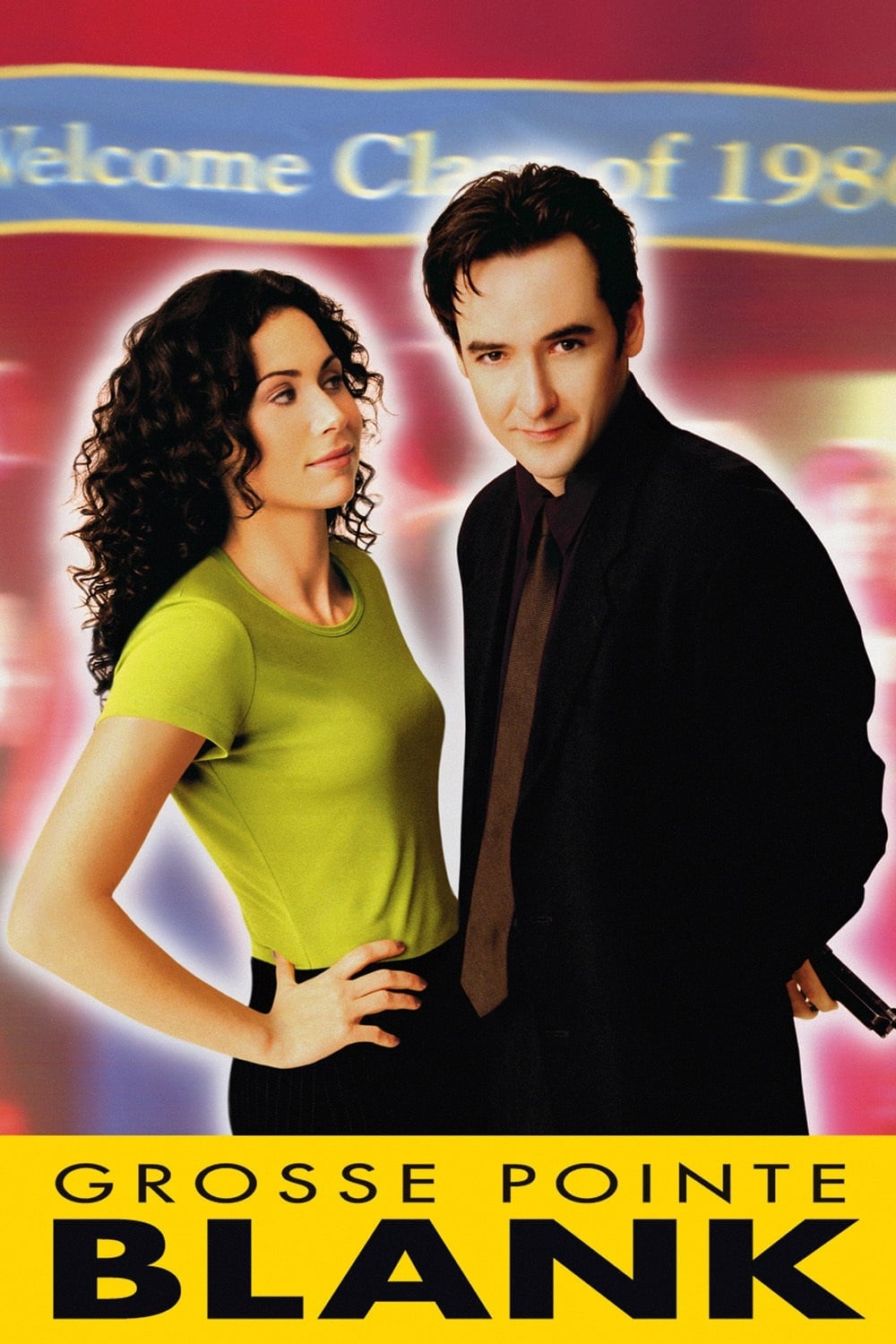Spoilers:
- Martin rekindles romance with Debi.
- Martin is a hitman on a job.
- Martin kills his rival hitman.
- Martin’s been away for ten years.
- Martin attends his high school reunion.
Grosse Pointe Blank: Key Statistics
- Release Year: 1997
- Director: George Armitage
- Genre: Comedy, Crime, Romance
- Main Cast: John Cusack, Minnie Driver, Dan Aykroyd, Joan Cusack
- Runtime: 107 minutes
- Budget: $15 million
- Box Office: $31 million
- Rotten Tomatoes Score: 80%
- IMDb Rating: 7.3/10
Overview
“Grosse Pointe Blank” is a black comedy crime film. It follows the story of Martin Blank, a professional assassin who attends his high school reunion.
Cast Highlights
- John Cusack as Martin Blank
- Minnie Driver as Debi Newberry
- Dan Aykroyd as Grocer
- Joan Cusack as Marcella
Critical Reception
Generally well-received for its blend of humor and action. Praised for its witty script and performances, especially John Cusack. Some criticism for plot predictability.
Grosse Pointe Blank, penned ingeniously by Tom Jankiewicz, explores profound depths of morality, self-identity, and the human condition through the unlikeliest of prisms: a hitman attending his ten-year high school reunion. It’s more than a satire on contemporary American values – it’s a poignant introspection on redemptive and transformative journeys. The narrative follows Martin Blank, navigating the nostalgic labyrinth of the past while concurrently wrestling with his chosen line of work. Trapped in a chimerical life, he epitomizes the paradoxical search for significance amid a world both profane and mundane. The film brilliantly exposes the existential crisis of a man grappling with his violent profession versus his desire for normalcy.The heart of the movie lies in its emotional depths; the romantic subplot is an intoxicating dance of delicate vulnerability and burgeoning redemption. The confluence of violence and surreal comedy is capably helmed by Jankiewickz, ensuring the stark contrasts resonate rather than repel. The screenplay’s genius lies in its sneaky subversiveness, embedding profound musings on life, love, and morality in tautly framed comic dialogue. It coerces the viewer into contemplating the human capacity for change and the inherent value of an ordinary life. The film flaunts a self-aware intelligence, injecting its killer ontology with a dose of humor, romance, and irony. Grosse Pointe Blank transcends its absurd premise to be thought-provoking and emotionally compelling; its identity crisis, relatable and real. Jankiewicz flawlessly humanizes the deadly protagonist, painting a masterpiece of morally grey realism.Grosse Pointe Blank isn’t just a film about a hitman’s existential crisis. It’s about every man’s quest for redemption, the struggle to reconcile past actions with current identities, and the inescapable pull of home. Filled with witty dialogue and profound insights, this movie remains an incredible testament to Jankiewicz’s screenwriting prowess.
Introduction to Grosse Pointe Blank
Released in 1997, “Grosse Pointe Blank” is a dark comedy film that offers a unique blend of action and humor. Directed by George Armitage, the film stars John Cusack, Minnie Driver, Dan Aykroyd, and Alan Arkin. The movie follows Martin Blank (Cusack), a professional hitman who returns to his hometown in Grosse Pointe, Michigan, for a high school reunion and a final assignment.
Interesting Facts
- “Grosse Pointe Blank” was filmed primarily in Monrovia, California, not Grosse Pointe, Michigan.
- Cusack co-wrote the screenplay with Tom Jankiewicz, D.V. DeVincentis, and Steve Pink, drawing on real-life inspiration for the eclectic reunion atmosphere.
- An iconic scene features Martin’s old house replaced by a convenience store, adding a touch of surreal humor.
Speculation and Trivia
There’s a bit of speculation surrounding the choice of Grosse Pointe as the setting. While some suggest it was picked for its affluent connotations, others point to its memorable-sounding name. The film’s eclectic soundtrack, featuring 80s hits, attracts attention. It’s rumored that Cusack insisted on some tracks, citing personal attachment.
Bizarre and Interesting Elements
- The blending of comedy with violence raises questions about genre norms. The film maintains a light tone even amidst chaos.
- The subplot involving Martin’s psychiatrist, played by Alan Arkin, offers comedic relief. It’s bizarre but memorable.
Public Perception Over Time
“Grosse Pointe Blank” received mixed reviews upon release, praised for unique storytelling and criticized for tonal shifts. Over time, it gained a cult following. Audiences appreciate its offbeat humor and sharp dialogue. The film often appears on underrated 90s movies lists, celebrated for breaking conventional molds.
Summary
In essence, “Grosse Pointe Blank” stands out in the cinematic landscape of the 90s. Its quirky plot and memorable performances anchor its appeal. While not a monumental box office hit, its enduring influence and quirky charm make it a notable entry in the decade’s filmography.
Grosse Pointe Blank’s Snappy Beat List
Lets dive right into the heart-pounding, laugh-out-loud beats of 1991’s dark comedy Grosse Pointe Blank, penned by Tom Jankiewicz. Quick, punchy, and straight to the point:
- Opening Hit – Martin Blank, our hitman with a heart… kind of, nails a job but botches a dog. Sets the tone: suave but screw-up.
- High School Reunion Invite – Blank gets an invite that screams midlife crisis but with a twist: he’s a professional killer considering going back to his hometown. This is his chance to reconnect and maybe find a sliver of redemption.
- Therapy Session – Even assassins need therapy. Martin’s session is a mix of hilarity and darkness, revealing his existential dread and loneliness.
- Deciding to Return – Blank chooses to face his past, a decision pushing him towards an inevitable chaos—career crisis, old flames, and unresolved high school drama.
- Road Trip to Grosse Pointe – A road trip filled with nostalgia and introspection. Martin’s journey is as much about going to a reunion as it is about confronting his life choices.
- Arrival and Recon – Blank arrives, checks out his old digs, and snoops around, setting up a collision course with his past and rivals. Awkwardness and danger loom.
- Reunion Encounters – Moment of truth as Martin faces old classmates, including the one that got away, Debi. Sparks fly, secrets nearly slip. His job shadows him.
- Confrontations – Enemies close in. From rival hitmen to government agents, Blank’s past and present career choice finally catches up with him. It’s messy, it’s hilarious, it’s violent.
- Rekindling with Debi – Amid chaos, old flames flicker. Martin and Debi’s reconnection is awkward yet genuine, providing a glimmer of hope for a man defined by death.
- Showdown at the Reunion – The main event: a shootout at the reunion. Dark comedy meets action as Blank battles foes with witty banter and bullets, all while 80s hits play.
- Climactic Choices – Life or death, stay or go, Blank is forced to make quick decisions that redefine his future. It’s about love, redemption, and surviving high school… again.
- A New Path? – The dust settles. Martin faces a choice: continue his life of crime or strive for something more, something resembling a normal life. It’s a hopeful, ambiguous end.
Grosse Pointe Blank delivers a comedic, yet introspective look at life’s second chances through the lens of a hitman’s existential crisis. Its beats pulse with action, heart, and humor, making it a unique ride from start to finish.

Story Opening in Writer’s Terms
The opening of “Grosse Pointe Blank” effectively establishes the mood and premise. We meet Martin Blank, played by John Cusack, who is a hitman grappling with the realities of his life choices. The film starts with a relatable but darkly comedic tone. The opening scenes lay out the conflict—a mix of personal and professional crises. It raises the stakes early on by placing the protagonist in a world of violence while making him surprisingly endearing. This immediately engages the audience.
Story Formula Breakdown
At its core, “Grosse Pointe Blank” follows a classic narrative structure that can be dissected into key components:
- Exposition: Introduces Martin Blank, a hitman with emotional baggage, returning to his hometown for a high school reunion.
- Inciting Incident: Martin receives a job assignment that overlaps with the reunion, complicating his return.
- Rising Action: Martin deals with old friends, former flame Debi Newberry (Minnie Driver), and new hitmen out to kill him.
- Climax: The tension peaks as Martin’s two worlds collide during the reunion, leading to a confrontation.
- Falling Action: Martin chooses his path, leading to personal revelations and decisions about love and life.
- Resolution: The film concludes with Martin leaving his hitman life for a chance at a normal relationship with Debi.
Character-Driven vs. Story-Driven
The story is primarily character-driven. While the plot mechanics are significant, it is Martin’s emotional journey that takes center stage. The film explores themes of identity, commitment, and the consequences of choices—driven by character motivations rather than just external events.
Memorable Character Traits
Martin Blank stands out because he is relatable despite his profession. His blend of cynicism, charm, and vulnerability makes him memorable. His internal conflicts resonate with anyone who has ever faced the dilemma of returning to their roots and confronting past choices. The humor derived from his situation adds to his character depth.
Main Characters
- Martin Blank: A professional assassin facing a midlife crisis. His journey back home forces him to confront his past and rethink his future.
- Debi Newberry: Martin’s former high school sweetheart, now working as a radio producer. She represents his lost chances and the possibility of change.
- Grocer: A former classmate, adds comic relief and a touch of nostalgia as Martin navigates his old life.
- Mr. Blank: Martin’s therapist, who mistakenly believes Martin’s professional challenges are comparable to normal civilian concerns.
- Other Hitmen: Serve to build the stakes around Martin’s dual life, highlighting both his skills as a killer and his desire to change.
Story Flow Template
To write a similar story, follow this flow:
- Protagonist Introduction: Establish main character’s profession and internal conflict.
- Inciting Incident: Present a situation that forces protagonist back into their past.
- World-Building: Show character’s relationship with their surroundings and significant people in their past.
- Obstacles Emergence: Introduce new conflicts arising from the character’s past blending with their present.
- Climactic Confrontation: Create a situation where characters must face their greatest fears or past actions.
- Character Resolution: Illustrate the protagonist’s choice and growth, leading to a satisfying end.
Story Summary
In simple terms, “Grosse Pointe Blank” is about a hitman who returns to his hometown for a high school reunion while grappling with his life choices. He reconnects with his past and must balance his old life of violence with the desire for normalcy and love. The film blends action and comedy effectively, probing what it means to redefine oneself amidst chaos.
Inciting Incident
The inciting incident in “Grosse Pointe Blank” occurs when Martin Blank receives an invitation to his high school reunion. This event pulls him back to his hometown, forcing him to confront his past and the life choices he’s made as an assassin.
Symbolism here is powerful. The reunion represents a chance for reconciliation and reflection on who he was versus who he has become. It highlights the theme of duality in his life—between being a killer and seeking normalcy.
Act Structure
The film follows a three-act structure:
- Act 1: Introduction of Martin Blank, his life as an assassin, and the setting of the upcoming reunion. We meet significant characters like his old flame, Debi, and his mentor, Grocer. It establishes the central conflict of trying to balance work and personal life.
- Act 2: Martin’s return home. The tension ramps up as he reconnects with Debi while trying to complete a job in the same town. This act explores themes of identity and choices. Flashbacks reveal why Martin left and how it shaped his current self.
- Act 3: The climax builds here as everything converges at the reunion. The overlapping of personal relationships and professional obligations peaks, leading to heightened stakes.
Climax
The climax occurs during the high school reunion, where Martin faces the ultimate choice between his violent life and the chance for love and a normal life with Debi. The emotional capital is tremendous—it’s a culmination of nostalgia, regret, and the hope for redemption. His decision signifies a break from his past and the potential to start anew.
The build-up includes moments of vulnerability with Debi, revealing his internal conflict. His assassin identity clashes with his desire for a normal life, creating a poignant tension that leads to this pivotal moment.
Tension and Release
The movie expertly builds tension through a mix of action and emotional stakes. Fights and hit jobs create suspense, while Martin’s interactions with his past and Debi add emotional weight.
Release comes during moments of humor and the final confrontation at the reunion. As he chooses love over his profession, the tension dissipates, leading to an overall feeling of hope. The pacing balances action and personal drama, maintaining engagement throughout.

Ending of Grosse Pointe Blank Explained
The ending of Grosse Pointe Blank sees Martin Blank, played by John Cusack, finally confronting his past. He attends his high school reunion, where he reconnects with his former crush, Debbie (Minnie Driver). After a series of action-packed events, Martin chooses love over his hitman career. He tosses away his gun, symbolizing his desire to leave that life behind. In a final showdown with an old associate, he survives and decides to pursue a normal life with Debbie.
How Writers Categorize the Ending
The ending can be categorized as a blend of romantic comedy and action film closure. It resolves the primary conflicts while leaning heavily on character growth and emotional resonance.
Symbolic, Thematic, and Speculative Meanings
- Symbolic: The gun symbolizes his violent past and the choice to abandon it for love.
- Thematic: Major themes include self-discovery, the struggle between personal and professional life, and the importance of second chances.
- Speculative: The future is left open; Martin’s decision suggests a potential for a more peaceful, fulfilling life.
Loose Ends and Payoffs
- Martin’s conflict with his father is resolved; he comes to terms with his family issues.
- The love story with Debbie reaches a satisfying point of connection.
- The hitman aspect is concluded, indicating Martin’s new direction in life.
Character Changes
Martin transitions from a coldhearted assassin to a man ready to embrace love and normalcy. Debbie evolves from a high school crush to a significant figure in Martin’s life, showcasing her strength and understanding.
Lessons for Writers
Writers can learn the importance of character arcs and the balance between humor and serious themes. A compelling ending should resolve key conflicts while allowing for character growth. Additionally, blending genres can create a unique viewing experience, keeping audiences invested until the last moment.
Dialogue Style in Grosse Pointe Blank
The dialogue in “Grosse Pointe Blank” stands out for its quick wit and dark humor, blending normal conversations with absurd elements typical of a hitman’s life. Characters exchange sharp banter, often reflecting their inner conflicts and backstories, making each interaction feel layered.
Quintessential Character Moment
A pivotal moment occurs when Martin Blank (John Cusack) meets his high school crush, Debi (Minnie Driver). Their conversation encapsulates the film’s essence: awkwardness, nostalgia, and an undercurrent of danger. The blend of normal life with extreme circumstances defines their exchanges.
Iconic Lines
- “I’m not a hitman; I’m a professional.”
- “You know what’s a real catch-22? I have to go back to my high school reunion and explain why I’m a professional killer.”
- “You should come to the reunion! It’ll be fun!”
Uniqueness of the Dialogue
It juxtaposes mundane life with chaotic elements. There’s a rhythm to the exchanges; they flow like a natural conversation yet hint at deeper issues. Humor keeps the tone light during grim situations, providing a counterbalance that keeps audiences engaged.
Dialogue Density
The script is dialogue-heavy, using conversations to build character development and plot dynamics. The interactions reveal backstory, relationships, and the protagonist’s conflict without excessive exposition.
Realism of the Dialogue
The dialogue feels authentic. Characters speak like real people—awkward pauses, interruptions, and relatable humor. Even in bizarre circumstances, their reactions resonate and lend credibility to the story.
Lessons for Writers
- Utilize wit to address serious themes.
- Make dialogue character-driven to enhance depth.
- Balance humor with tension to maintain engagement.
Scene Walkthrough
In the reunion scene, Martin arrives and finds Debi. Their initial exchanges are laced with nostalgia and tension.
Debi: “So what do you do now, Martin?”
Martin: “It’s complicated… I handle certain situations.” (smirks)
Commentary: This establishes his covert life. The light sarcasm from Martin reveals his discomfort while hinting at a darker reality. Debi’s curiosity adds layers; she’s trying to connect and understand. It’s funny yet poignant.
Debi: “You’re not that guy who made bombs in high school, right?”
Martin: “Only exploded a few things. That was more of a hobby.” (grins)
Commentary: Their banter implies past experiences and unresolved feelings. It’s a clever mix of humor and acknowledgment of their shared history. The dialogue unfolds naturally, enhancing their chemistry.
This scene encapsulates the movie’s tone—normalcy amidst chaos—showing how dialogue can blend humor with serious undertones effectively.
Grosse Pointe Blank
A hitman returns to reunite,
High school dreams intertwined with night,
Calculating love in a dance of fate,
Deadlines loom as hearts contemplate.
Mortality’s humor, absurdly on cue,
A planner of death with a therapist too,
Witty exchanges over bags of despair,
While old friends pass like a sliver of air.
A wedding to crash, or a history to mend,
Life is a contract, we must all attend,
With patience and chaos, a glimmering trace,
In silent reflections, we find our own grace.
Writing Lessons from Grosse Pointe Blank
Grosse Pointe Blank is more than just a dark comedy about an assassin. It has unique insights for writers.
1. Blend Genres Seamlessly
The film fuses action, romance, and comedy. Don’t be afraid to mix genres to create something fresh.
2. Write Relatable Flaws
Martin Blank is a hitman with commitment issues. Flawed characters make audiences connect. Make your characters real.
3. Use Dialogue as Insight
The banter reveals character depth. Use snappy dialogue to show, not tell, who your characters are.
4. Timing is Key
Both comedic and dramatic moments rely on pacing. Pay attention to timing in your scenes for maximum impact.
5. Setting as Character
Grosse Pointe serves as a backdrop but also a character itself. Make your setting an integral part of the story.
6. Explore the Mundane in Extraordinary Contexts
The contrast of a high-stakes profession in a suburban setting is striking. Find humor and depth in mundane environments.
7. Embrace Ambiguity
Not everything is neatly resolved. Leaving some questions unanswered can create intrigue.
8. Use Nostalgia Wisely
The film plays on high school memories. Leverage nostalgia to evoke emotion, but don’t make it a crutch.
9. Create Relatable Stakes
Martin’s internal conflict about love versus his job makes stakes personal. Writers should connect plot stakes to character desires.
10. Subvert Expectations
This film turns the assassin trope on its head. Challenge conventions to keep your audience guessing.
Tom Jankiewicz Discography
Tom Jankiewicz is an accomplished author and screenwriter known for his sharp wit and insightful storytelling. His discography includes:
- Grosse Pointe Blank (1997) – Co-writer of the screenplay for this dark comedy about a hitman attending his high school reunion.
- War, Inc. (2008) – Co-writer, a political satire that critiques the privatization of warfare.
- One Day at a Time (2020) – Contributed to the revival of the classic sitcom focusing on a Cuban-American family.
- Other Works – Various short stories and contributions to anthologies, showcasing his range in writing.
Writing Style
Tom Jankiewicz’s style is characterized by sharp humor and engaging dialogue that delivers both entertainment and social commentary.
Review 1: Excerpt: “An wry blend of deadpan humor and hit-man action, this quietly funny if rather strange comedy has been launched almost under the critics’ radar. But put us on record as smiling. It is a very likable, very funny sleeper, bafflingly unheralded.”Source: Variety Review by Deborah Younghttps://variety.com/1997/film/reviews/grosse-point-blank-1117433690/Review 2:Excerpt: “Grosse Pointe Blank isn’t perfect, and there are times when it’s easy to wish for a little more depth or less mayhem. But, overall, the film works as entertainment – pure and not-so-simple. It’s certainly the funniest thing to come along since last year’s Scream. And the death toll is similar.”Source: ReelViews Review by James Berardinellihttps://www.reelviews.net/reelviews/grosse-pointe-blankReview 3:Excerpt: “A quirky blend of comedy, romance, and modestly scaled action scenes are served up in an appealingly offbeat package called Grosse Pointe Blank. A little more substance and a better defined dramatic focus would have helped, especially toward the end, but as in the earlier “Hi, Mom!,” it remains a basically engaging, idiosyncratic diversion throughout.”Source: The Hollywood Reporter Review by Duane Byrgehttps://www.hollywoodreporter.com/movies/movie-reviews/grosse-pointe-blank-996274/Review 4:Excerpt: “Grosse Pointe Blank is funny, with killer lines. But it’s also harrowing. Cusack, a deft comic actor, knows how to bring out the melancholia in the gags. It’s a hilarious comedy, all right. But the cathartic climax makes the laughs catch in your throat.”Source: Rolling Stone Review by Peter Travershttps://www.rollingstone.com/movies/movie-reviews/grosse-pointe-blank-102135/Review 5:Excerpt: “Cusack powers a film that’s both hilarious and touching, crafting a fun and strangely reflective look into the life of a man whose career has stalled in a very unusual way. Grosse Pointe Blank is an oddball success.”Source: Empire Review by Trevor Johnstonhttps://www.empireonline.com/movies/reviews/grosse-pointe-blank-review/
- Tom Jankiewicz – Wikipedia
- Whatever happened to Tom Jankiewicz, the writer of Grosse Point …
- Grosse Pointe Blank – Wikipedia
- 13 Close-Up Facts About Grosse Pointe Blank
- GROSSE POINTE BLANK Screenwriter Tom Jankiewicz, 49
- Script To Screen: “Grosse Pointe Blank” | by Scott Myers | Go Into …
- GROSSE POINTE BLANK
- Grosse Pointe Blank screenwriter dies after collapsing at CSUSB …
- Books by Tom Jankiewicz (Author of Grosse Pointe Blank)
- Grosse Pointe Blank [DVD] : John Cusack, Minnie … – Amazon.com




Leave a Reply